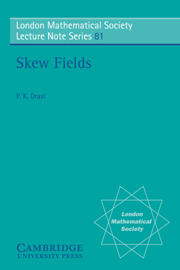Part II - Skew Fields and Brauer Groups
Published online by Cambridge University Press: 04 August 2010
Summary
The history of Brauer groups began in 1929 when R. Brauer (1902–1977) proved that the set of those (isomorphism classes of) skew fields which are finite dimensional over their common centre K can be endowed with the structure of an abelian torsion group. This group is nowadays called the Brauer group Br(K) and turns out to be a subtle invariant of K which is closely related to Galois Cohomology via the crossed products (“verschränkte Produkte” in the original German terminology), as was first shown by E. Noether (1882–1935). Of course, in those days there was no Galois Cohomology, so what she suggested was the heart of a theory which was to become Galois Cohomology after general (co)homology theories had been developed later in the 1940's. Meanwhile, in the 1930's A.A. Albert (1906–1972), R. Brauer, E. Noether and H. Hasse (1898– –1979) gave a comprehensive treatment which culminated in a complete determination of Br(K) in the case where K is an algebraic number field. All this is summed up in the two reports M. Deuring [1935] and A.A. Albert [1939] which are even today outstanding reading matter.
Here (in Part II of these lectures) we attempt to give a comprehensive treatment of the basic algebraic aspects of a modern theory of Brauer groups over fields.
- Type
- Chapter
- Information
- Skew Fields , pp. 57 - 58Publisher: Cambridge University PressPrint publication year: 1983

